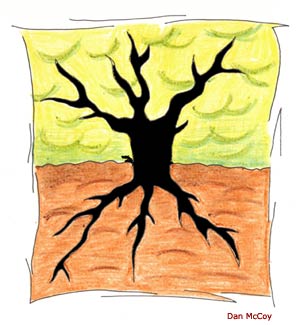|
Once upon
a time, all cottonwood trees stood alone. Two or three slim trunks
dotted the same hillside, but they never grew close enough together
that they could hear one another. Cottonwoods liked their privacy.
They had enjoyed peace for many decades, some say centuries, when
Weather, that unpredictable force, altered their lives permanently.
 It
had been a particularly rainy spring. Leaves thrust out from twigs
early, bark glistened, moss grew. Rain spilled down for days, which
turned into weeks. The cottonwoods basked in the moisture, soaking,
reveling, gulping, filling themselves swollen. They drank until
they could drink no more. And the Rain washed them, sluicing through
the sky, massaging the ground, tattooing their leaves. It
had been a particularly rainy spring. Leaves thrust out from twigs
early, bark glistened, moss grew. Rain spilled down for days, which
turned into weeks. The cottonwoods basked in the moisture, soaking,
reveling, gulping, filling themselves swollen. They drank until
they could drink no more. And the Rain washed them, sluicing through
the sky, massaging the ground, tattooing their leaves.
The doddering Sun hoisted herself above
the horizon every day, and yet the cottonwoods became unsure of
her presence. Without her warmth, without the phototropic draw of
leaf toward sky, the cottonwoods lost their sense of direction–which
was up and which was down? The shimmering green of their leaves
paled to a dingy yellow.
It started as a murmur, a whispering of
foliage: Alone. Lost. Gone. And as the grayness persisted, the complaints
grew in intensity and in volume. For the first time, the cottonwoods
heard the rustle of each other’s voices. Alone. Lost. Gone.
Despite their distress, the sound buoyed them, engendering strength
and the hope of change. All the while, clouds held back the mirth
of the Sun. Rain pelted the cottonwoods, soaked their bark, moldered
their drooping leaves, until they could stand no more.
"She has abandoned us," they
cried. Their voices surged together, a wave that broke through the
clouds and reached the very Sun herself.
"I have done no such thing,"
the Sun replied, and she turned her gaze on the muddy cottonwoods,
their limp leaves and water-weakened boughs. The clouds hovering
over the cottonwoods boiled into vapor. Mists swirled from the Sun-warmed
puddles at their feet. The grayness sprinted from her fierce smile,
and she gave chase. Summer bloomed. The Sun grinned down on the
complaining trees, ferreted out the last corners of shadow, the
last vestiges of mold.
In her brightness, the cottonwoods trembled
and fell silent. At first their tremor mimicked the normal shimmer
of their re-greening leaves. After some time had passed, some say
weeks, others months, and still no cloud had flickered through the
sky, the cottonwoods shook at their roots, and their roots shifted
in the Rain-loosened soil.
The dryness of early summer turned to
drought. The cottonwoods shook and shimmered, their once-green leaves
enveloped in dust. Browning, their leaves rattled in the scorching
wind. Peering from their hillsides, the cottonwoods fixed upon the
flowing water of the valley. They shifted toward the gurgling, and,
as their roots remained unmoored, they glided, just slightly, downhill.
Eager to slake their thirsts, they pressed on, crackling the underbrush,
skirting the burning faces of boulders. Cowering from the Sun, they
traveled at night and settled on the banks of the River. There they
drank, their leaves plumped, and their boughs rounded. Some say
at twilight they even frolicked, splashing each other and lolling
in the shallows. But soon the River dried to dust, and the Earth
began to harden around their roots. Their movements slowed. All
play stopped.
The cottonwoods, eyeing the wetness in
each others leaves, sensing the humidity of root, the underside
of bark, crept into pairs. They sidled closer, and by the end of
the dry summer, as the planet moved into an arid fall, the trees
touched. At first, twig brushed twig. Then they intertwined. Branches
drew each other in and trunks pressed close. They drank of each
others’ sap. Equally matched in thirst and strength, they neither
drained each other nor were they drained. The fluids re-circulated
from tree to tree, and because of this movement, the limited waters
sufficed. Twining, twisting together, each pair of cottonwoods bonded,
forming a single, massive trunk.
Eventually, the Rain returned, the River
poured itself the length of its bed, and the Sun, mollified, laughed
lightly. The pairs of cottonwoods forgot the quiet height of their
hillsides and rooted themselves in their valley homes. Over time,
each cottonwood forgot that it had ever lived alone. Now the cottonwoods
imagine that they have always been stout, river-dwelling trees.
Despite the sweetness of the Sun and the nourishment of the Rain,
each pair of cottonwoods clings close, together as one. To this
day, they dare not let go. And that is how the cottonwood learned
to embrace.

|
